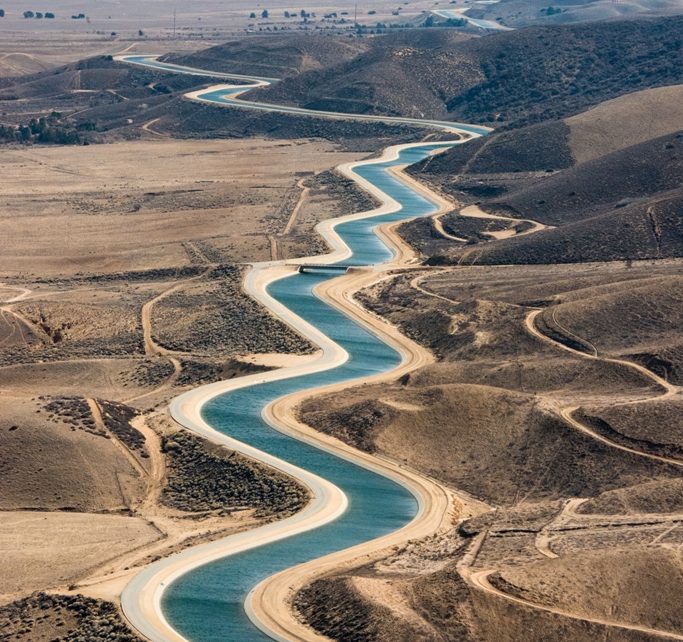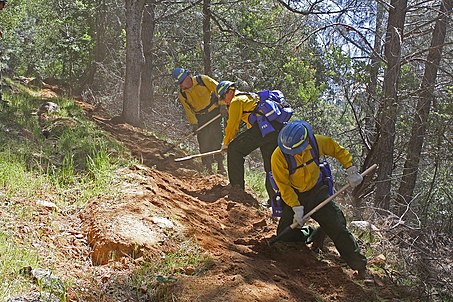
The California Aqueduct. (Photo: CA State Water Project)
California’s Four Water Entities: What’s the Difference?
The DWR manages California’s water resources, systems, and infrastructure, including the State Water Project
By Chris Micheli, September 10, 2020 6:19 am
California has four water-related entities: California Water Commission, California Water Quality Monitoring Council, Department of Water Resources, State Water Resources Control Board. What are the differences?
California Water Commission
In Water Code Division 1, Chapter 2, Article 2, Section 150, there is established a California Water Commission in the Department of Water Resources. Section 151 specifies that the Commission has nine members are who are appointed by the Governor and confirmed by the State senate. Seven members are chosen for their expertise related to the control, storage, and beneficial use of water and two are chosen for their knowledge of the environment
According to the Commission, it provides a public forum for discussing water issues, advises the Director of the Department of Water Resources on matters within the Department’s jurisdiction, approves rules and regulations, and monitors and reports on the construction and operation of the State Water Project. The Commission also distributes public funds set aside for the public benefits of water storage projects.
The roles and responsibilities of the California Water Commission are defined in the Water Code, as well as sections of the Government Code and the Civil Procedures Code.
California Water Quality Monitoring Council
Water Code Division 7, Chapter 3, Article 4, Section 13181 requires the California Environmental Protection Agency and the Natural Resources Agency to enter into a memorandum of understanding for the purposes of establishing the California Water Quality Monitoring Council, which is administered by the State Water Resources Control Board.
The California Water Quality Monitoring Council includes representatives from state entities and nonstate entities, such as representatives from federal and local government, institutions of higher education, the regulated community, citizen monitoring groups, and other interested parties. The Council is required to review existing water quality monitoring, assessment, and reporting efforts, and recommend specific actions and funding needs necessary to coordinate and enhance those efforts.
In November 2007, a Memorandum of Understanding (MOU) was signed by the Secretaries of the California Environmental Protection Agency (CalEPA) and the California Natural Resources Agency to establish the California Water Quality Monitoring Council (Monitoring Council). The MOU was mandated by CA Senate Bill 1070 (Kehoe, 2006) and requires the boards, departments and offices within CalEPA and the Resources Agency to integrate and coordinate their water quality and related ecosystem monitoring, assessment, and reporting.
According to the Council, the Monitoring Council may recommend new monitoring or management initiatives, it will build on existing effort to the greatest extent possible. The Monitoring Council published its initial recommendations in December 2008, and its recommendations for A Comprehensive Monitoring Program Strategy for California in December 2010.
Department of Water Resources
Water Code Division 1, Chapter 2, Article 1, Section 120 provides that there is in the Resources Agency the Department of Water Resources, which is under the control of an executive officer known as the Director of Water Resources. The director is appointed by the Governor and holds office at the pleasure of the Governor. The appointment of the director is subject to confirmation by the State Senate.
Section 123 provides that the Department succeeds to and is vested with all of the powers, duties, purposes, responsibilities, and jurisdiction in matters pertaining to water or dams vested in the Department and Director of Public Works, the Division of Water Resources of the Department of Public Works, the State Engineer, the Water Project Authority of the State of California, or any officer or employee.
According to the Department, the DWR manages California’s water resources, systems, and infrastructure, including the State Water Project (SWP), in a responsible, sustainable way.
The Department’s responsibilities and duties include:
- Preventing and responding to floods, droughts, and catastrophic events
- Informing and educating the public on water issues
- Developing scientific solutions
- Restoring habitats
- Planning for future water needs, climate change impacts, and flood protection
- Constructing and maintaining facilities
- Generating power
- Ensuring public safety
- Providing recreational opportunities
State Water Resources Control Board
Water Code Division 1, Chapter 2, Article 3, Section 175 establishes the State Water Resources Control Board. Section 174 provides a series of legislative findings and declarations. For example, one finding is that, in order to provide for the orderly and efficient administration of the water resources of the state, it is necessary to establish a control board that shall exercise the adjudicatory and regulatory functions of the state in the field of water resources.
It is also the intent of the Legislature to combine the water rights, water quality, and drinking water functions of the state government to provide for coordinated consideration of water rights, water quality, and safe and reliable drinking water.
Section 175 provides that there is in the California Environmental Protection Agency the State Water Resources Control Board consisting of five members appointed by the Governor. One of the members appointed must be an attorney who is qualified in the fields of water supply and water rights, one shall be a registered civil engineer who is qualified in the fields of water supply and water rights, one shall be a registered professional engineer who is experienced in sanitary engineering and who is qualified in the field of water quality, and one shall be qualified in the field of water quality.
The members are required to serve full time and be composed of members from different regions of the state. The members are appointed by the Governor and are subject to confirmation by the State Senate. Pursuant to Section 179, the board succeeds to and is vested with all of the powers, duties, purposes, responsibilities, and jurisdiction vested in the Department and Director of Public Works, the Division of Water Resources of the Department of Public Works, the State Engineer, the State Water Quality Control Board, or any officer or employee.
- Intercountry Adoptions - January 11, 2026
- The Uniform Foreign-Money Claims Act - January 10, 2026
- General Provisions of California’s LLC Act - January 10, 2026





A quick look reveals lots of over lap of duties at large salaries. Consolidate!
FOUR???
Are you effing KIDDING US???
No wonder this state is failing financially!!! All those gubmint workers pulling down above market salaries with gold-plated pensions for life at 55 to essentially manage and fight over the same resource and voila, you have a state that’s inefficiently managed….
And yet billions of gallons of water waste out to sea every time we get a pineapple express deluge because these “experts” haven’t built a damn thing to capture or culture fresh water since the Kennedy administration….
Thanks for pointing out yet another reason to get the hell out of here and come back to visit on vacation….
Very informative. Thank you.
Learn from the mother of all parliaments. One must achieve financial freedom for oneself by levying ever increasing taxes upon We the People. The gargantuan gap between the public and private sectors on retirement income didn’t happen overnight. It has taken decades of successive self serving politicians manipulating statistics all for the purposes of continuing DB accrual for themselves.
In fiscal year 05/06 the financial shortfall for public sector OCCUPATIONAL pensions was an insignificant 200m. This shortfall to satisfy the expectations of those whose sense of entitlement can only be described as breathtaking increased to 15.4 billion a decade later (2015/16)
Few realise the Government fund this shortfall from the Welfare Budget. I thought that was earmarked for the less fortunate …….. is funding pensions apartheid good use of this pot of taxpayers money?
Why, in 2000 did the then Labour Government decide to reclassify BBC, Post Office et al employees as usddenly existing in the private sector for the purposes of reporting occupational pension statistics? (to hide the terminal decline of DB in the private sector)
Which private sector organisations continue to accrue DB benefits?? Those in monopoly positions who masquerade as private sector companies. Think water distribution, electricity, gas, network rail “et al”
The gap is truly disgusting. We have the worst pensions apartheid in the OECD. Created knowing and by design by corrupt politicians. “All in it together” what BS they spew. Little wonder people don’t bother voting.
Happiest nation on earth? Denmark
Balanced fiscal position? Denmark
Least corrupt nation on earth? Denmark
Highest voter turnout? Denmark (with exception of countries where voting is compulsory ….. this is how they hide breakdown of trust)
……….. who abandoned DB for ALL decades ago ??? ……….. Denmark
Those with skin in the game insist on abandoning their honour and integrity to defend the corrupt status quo. Governments throughout the OECD learn from the mother of all parliaments. One must take what one needs when one needs it regardless of the dire social and economic circumstances.
The system is broken and rigged. We the People have been financially enslaved for decades to come all to satisfy the breathtaking sense of entitlement of those who purport to serve.
NHS? Previously accrued at 80th’s final salary. The corrupt politicians introduced Career Average Related Earnings (CARE) to “save” taxpayers money. What they didn’t tell you? The accrual rate moved to 51st’s. What is more expensive for the taxpayer? 10/80th’s of say 50k per annum or 10/51st’s? What produces the higher pension in an era of flatlining salaries?
Are you awake? #4hardtruths